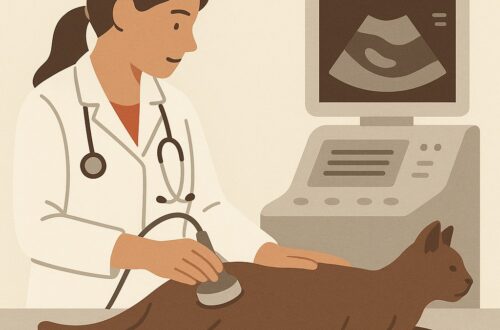As a clinician, educator, and administrator, I deal with a lot of poop – figuratively and literally. One of the most common problems I encounter is a pet with chronic gastrointestinal signs (e.g. vomiting, weight loss, diarrhea) and a concurrently low blood protein level. This is called a protein-losing enteropathy or PLE. This week I’ve dedicated some time to spreading information about this common clinical scenario. Happy reading!
Protein-Losing Enteropathy – What is it?
I like to keep things simple whenever possible. When it comes to blood protein – mostly proteins called albumin and globulins – there are three major reasons for this protein to decrease:
- Loss through the feces
- Loss through the urine
- Synthetic failure by liver
This week we’re focusing on #1. Any condition of the gastrointestinal tract that causes albumin to be lost in the feces is called a protein-losing enteropathy. Several dog breeds are over-represented, including soft-coated Wheaten terriers, Rottweilers, and Silky terriers. There are many potential causes of PLE in dogs and cats, and these can be easily categorized:
- Inflammatory bowel disease (IBD)
- Infectious Diseases – fungal (e.g.: histoplasmosis), parasites (e.g.: coccidia, giardia, hookworms, whipworms), pythiosis,
- Cancer (e.g.: lymphoma)
- Lymphangiectasia – an abnormality of lymph system vessels in the intestinal tract; some dog breeds (e.g.: Yorkshire terriers, Maltese, Norwegian lundehund) have a genetic predisposition to this condition
- Chronic intussusception – an anatomical abnormality characterized by the intestines telescoping on themselves
- Antibiotic responsive diarrhea
- Intestinal erosions & ulcerations
- Congestive heart failure
Below is a video of a Yorkshire Terrier undergoing a procedure called endoscopy. In the video, you will see gross changes consistent with lymphangiectasia. This patient was also diagnosed with concurrent inflammatory bowel disease (IBD).
Protein-Losing Enteropathy – What does it look like?
Classically, pets with protein-losing enteropathies have chronic and intermittent gastrointestinal signs like vomiting, diarrhea, weight loss, and/or reduced (or loss of) appetite. The signs may be subtle, and may even wax and wane. Interestingly some pets have no clinical signs, and the only abnormality is documenting low blood proteins.
Albumin is a major protein body in the body. It has many important functions. One of its vital jobs is to keep fluids in the appropriate places like inside the blood vessels. If you’re a science nerd like me, you’ll know this relationship is called the Gibbs-Donnan equilibrium. For those of you who are less science inclined, think about it like this. Albumin is like a water magnet. It keeps fluid in the blood vessels. When albumin is low, that “magnetic force” is reduced, and fluid can leave the vessels. The result? Swelling of the limbs and skin develops – this is called edema. Most commonly fluid accumulates in the abdominal fluid and between the lungs and body wall; these abnormalities are called peritoneal effusion and pleural effusion, respectively.
Protein-Losing Enteropathy – How is it diagnosed?
Veterinarians will perform some initial blood, urine, and fecal tests, most commonly a complete blood count (CBC), biochemical profile (CHEM), urinalysis (UA), and fecal tests to screen for intestinal parasites like Giardia spp. and Coccidia spp. Additional testing invariably needed, and will vary depending on your pet’s history and your geographic location. Possible supplemental tests are:
- ACTH stimulation test – to screen for hypoadrenocorticism | Addison’s disease
- Urine fungal screening – to search for histoplasmosis
- Cobalamin (Vitamin B12) & folate (Vitamin B9) measurement
- Testing for pancreatic inflammation (pancreatitis) and function (exocrine pancreatic inflammation)
- Alpha-1 protease inhibitor measurement – a special fecal test that can identify extra protein loss in feces
- Evaluation of peritoneal and/or pleural effusion
- Liver function testing (e.g.: serum bile acids, blood ammonia) to confirm normal ability to make protein
- Antithrombin level – a protein that is approximately the same size as albumin that can also be lost in feces; when levels are too low, a patient is at risk for development abnormal blood clots
- Chest and abdominal imaging (e.g.: x-rays, sonography)
- Gastrointestinal biopsies
Pet parents will likely find it helpful to partner with a board-certified veterinary internal medicine specialist to develop a logical and cost-effective diagnostic plan.
Protein-Losing Enteropathy – How is treated?
As you’ve figured out by this point, there are many types of PLEs. Each one is treated differently. Some problems can be cured. Most can’t be. A few are lethal. Thankfully, many can be medically managed successfully and chronically. I encourage pet parents to work closely with their family veterinarian, as well as to collaborate with a board-certified veterinary internal medicine specialist to ensure their fur babies receives the most appropriate therapies.
The take-away message about protein-losing enteropathy…
Proteins are very important. Unfortunately, many diseases can cause them to be lost in feces. Collectively, these problems are called protein losing enteropathies. With early diagnosis and effective treatment, most pets can live high quality lives.
To find a board-certified veterinary internal medicine specialist, please visit the American College of Veterinary Internal Medicine.
Wishing you wet-nosed kisses,
cgb






